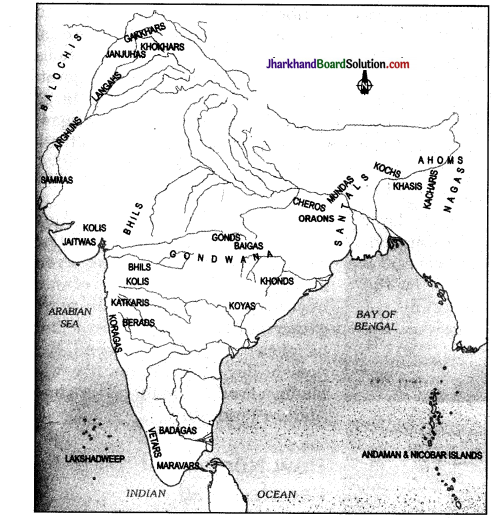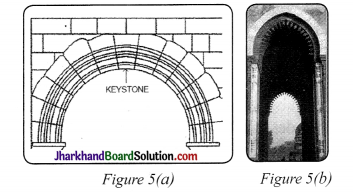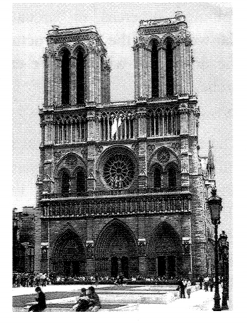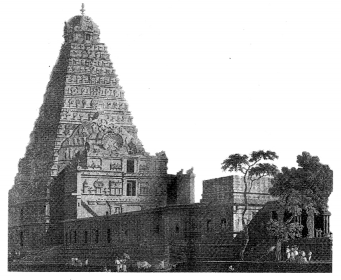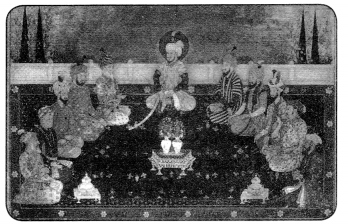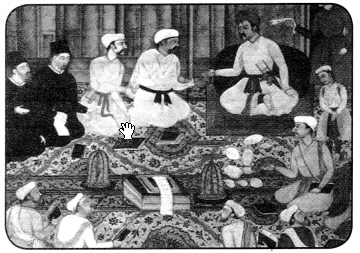JAC Board Class 7th Social Science Solutions History Chapter 9 The Making of Regional Cultures
JAC Class 7th History The Making of Regional Cultures InText Questions and Answers
Page 122
Question 1.
Find out how many states have been created in the last 10 years. Is each of these states a region?
Answer:
The four states Uttarakhand, Jharkhand, Chhattisgarh and Telengana have been created in the last 10 years. Yes, each of these state is a region.
![]()
Page 123
Question 2.
Find out when the languages you speak at home were first used for writing.
Answer:
Need to do it yourself with the help of teacher or parents. (Hint: Most probably around 9th century the languages were first used for writing)
Page 126
Question 3.
Find out whether there are traditions of heroes/heroines in your town or village. What are the qualities associated with them? In what ways are these similar to or different from the heroic ideals of the Rajputs?
Answer:
Need to do it yourself. (Hint: Any local hero/heroes would possess the qualities of a loyalty, friendship, love, anger, bravery, etc. Most of these qualities would be similar to ideals of the Rajputs.)
Page 127
Question 4.
Find out more about any one of these dance forms.
Answer:
Bharatanatyam is a dance of Tamil Nadu in southern India. It traces its origins back to the Natyashastra, an ancient treatise on theatre written by the mythic priest Bharata. Originally a temple dance for women, bharatanatyam often is used to express Hindu religious stories and devotions.
It was not commonly seen on the public stage until the 20th century. The dance movements are characterized by bent legs, while feet keep rhythm. Hands may be used in a series of mudras, or symbolic hand gestures, to tell a stoiy. Classical dance in India is based upon and influenced by the Natya Shastra, an ancient Indian text that is the foundation for performing arts.
Page 130
Question 5.
While Bengali is now recognised as a language derived from Sanskrit, early Sanskrit texts (mid-first millennium BCE) suggest that the people of Bengal did not speak Sanskritic languages. How, then, did the new language emerge?
Answer:
Bengali is a language spoken mostly in the state of Bengal and by Bengalis. Bengali is now recognised as a language derived from Sanskrit, but early Sanskrit texts (mid-first millennium BCE) suggest that the people of Bengal did not speak Sanskritic languages. From the fourth-third centuries BCE, commercial ties began to develop between Bengal and Magadha (south Bihar), which may have led to the growing influence of Sanskrit.
During the fourth century the Gupta rulers established political control over north Bengal and began to settle Brahmanas in this area.Thus, the linguistic and cultural influence from the mid-Ganga valley became stronger. In the seventh century the Chinese traveller Xuan Zang observed that languages related to Sanskrit were in use all over Bengal.
![]()
Page 132
Question 6.
Why do you think the second category of texts was not w ritten down?
Answer:
The second category of early Bengali literature was orally transferred to the new generation and not written down.
Page 133
Question 7.
Compare the temple shown here with that in Chapter 2.
Answer:
The temple in Chapter 2 is that of Gangaikonda cholapuram. The temple is built of stone and rock. The intricate designs on the roof of the temple which becomes narrow is the most significant features of this temple. On the other hand, the temple shown here describes a very unique feature of Bengal architecture. It was built on a square platform with a plain interior and exterior have decorative walls, ornamental tiles or terracotta shape and a double roof thached hut shape.
Page 136
Question 8.
Imagine, you are a Rajput prince. How would you like your story to be told?
Answer: Do it yourself.
JAC Class 7th History The Making of Regional Cultures Textbook Questions and Answers
(Let’s Recall)
Question 1.
Match the following:
| Anantavarman | Kerala |
| Jagannatha | Bengal |
| Mahodayapuram | Orissa |
| Lilatilakam | Kangra |
| Mangalakavya | Puri |
| Miniature | Kerala |
Answer:
| Anantavarman | Orissa |
| Jagannatha | Puri |
| Mahodayapuram | Kerala |
| Lilatilakam | Kerala |
| Mangalakavya | Bengal |
| Miniature | Kangra |
Question 2.
What is Manipravalam? Name a book written in that language.
Answer:
Manipravalam precisely means diamonds and corals and here it is a language. The name of a book written in that language is Lilatilakam, which deals with grammar and poetics.
Question 3.
Who were the major patrons of Kathak?
Answer:
Kathak began evolving into a distinct mode of dance in the fifteenth and sixteenth centuries with the spread of the bhakti movement. The legends of Radha-Krishna were enacted in folk plays called rasalila, which combined folk dance with the basic gestures of the kathak story-tellers.
Under the Mughal emperors and their nobles, Kathak was performed in the court, where it acquired its present features and developed into a form of dance with a distinctive style. Subsequently, it developed in two traditions or gharanas: one in the courts of Rajasthan (Jaipur) and the other in Lucknow. Under the patronage of Wajid Ali Shah, the last Nawab of Awadh, it grew into a major art form.
![]()
Question 4.
What are the important architectural features of the temples of Bengal?
Answer:
The important architectural features of the temples of Bengal were as follows:
- When local deities got recognised by the Brahmanas, their images began to be housed in temples.
- The double roofed or four roofed structure of the thatched huts were copied by the temples.
- Temples were mostly built in square platform.
- The interior of the temple were usually plain but the exterior were decorated with paintings, ornamental tiles or terracotta tablets.
- In the relatively more complex four roofed structure, four triangular roofs placed on the four wall move up to coincide on a curved line or a point.
- In some temples, particularly in Vishnupur in the Bankura district ‘ of West Bengal, such decorations reached a high degree of excellence.
(Let’s Discuss)
Question 5.
Why did minstrels proclaim the achievements of heroes?
Answer:
Minstrels proclaimed the achievements of heroes because of the following reasons:
- They used to recite poems and songs which depicted the tales and stories of the Rajput’s heroic deeds.
- They inspired others to follow the examples of the Rajputs.
- Common and ordinary people were also attracted by these stories which often depicted dramatic situations and a range of strong emotions loyalty, friendship, love, valor, anger, etc
Question 6.
Why do we know much more about the cultural practices of rulers than about those of ordinary people?
Answer:
Rulers were rich in power and wealth. They adopted several methods to preserve their achievements. Stories about Rajput heroes were recorded in poems and songs, which were recited by specially trained minstrels. Rulers patronised highly skilled painters who primarily-illustrated manuscripts containing historical accounts and poetry.
These were generally painted in brilliant colours and portrayed court scenes and other aspects of social life. Rulers spent a huge wealth on building temples to establish their power and status. Ordinary people did not do anything to preserve the records of their heroic deeds. The aforementioned reasons clearly show why we know more about the cultural practices of rulers than those of ordinary people.
Question 7.
Why did conquerors try to control the temple of Jagannatha at Puri?
Answer:
The conquerors tried to control the temple of Jagannatha at Puri because the temple gained the importance as a centre of pilgrimage. Its authority also increased in terms of social and political matters. Thus, they felt that this would make their rule acceptable to the local people.
Question 8.
Why were temples built in Bengal?
Answer:
Temples were built in Bengal for the following reasons:
- From the late fifteenth century, temple building in Bengal got momentum till the nineteenth century.
- Groups or individuals built temples to demonstrate and show their power and wealth.
- With the support of various social groups, some of the temples got constructed.
- New economic opportunities to people also helped in temple building to show their status.
- Local deities once worshipped in thatched roof got recognition by Brahmanas. The recognition shifted them from the thatched hut to brick built temples.
(Let’s Do)
Question 9.
Describe the most important features of the culture of your region, focusing on buildings, performing arts and painting.
Answer:
Need to do it yourself. (Hint : Suppose, I live in Delhi. From beginning itself it has been a land of mixed culture and traditions. In olden days, it has been invaded many times and had been ruled by many rulers. They all affected its culture, religion, language, architecture, society, art, painting etc. We have monuments and buildings built by Mughals, Rajput rulers and many more. We also have temples, mosques built by different rulers. We can see the differences of culture in old and new Delhi now as well).
![]()
Question 10.
Do you use different languages for
(a) speaking,
(b) reading,
(c) writing? Find out about one major composition in language that you use and discuss why you find it interesting.
Answer:
Use of different language for speaking, reading and writing:
- For speaking I use Hindi, English and Punjabi.
- For reading I use Hindi and English.
- For writing I use Hindi and English only.
Question 11.
Choose one state each from north, west, south, east and central India. For each of these, prepare a list of foods that are commonly consumed, highlighting any differences and similarities that you notice.
Answer:
| States | Foods List |
| North – Punjab | Rajma-chawal, Makke di rod and sarson da saag, gobhi-paratha |
| South — Karnataka | Idli-Dosa, Sambhar, Rice and fish |
| East – West Bengal | Rice and Fish, mutton curry, different types of vegetables |
| West – Rajasthan | Daal-bati-churma, pyaj kachori, mawa kachori |
| Central – Madhya Pradesh | Dal-chapatis |
Similarities and differences: Rice and chapattis are common throughout India. But in some parts of India non-vegetarian foods are popular.
Question 12.
Choose another set of five states from each of these regions and prepare a list of clothes that are generally worn by women and men in each. Discuss your findings.
| States | Clothes worn – men | Clothes worn – women |
| North – Punjab | Lungi, kurta and turban | Churidar kurta, salwar kameez and dupatta |
| South – Tamil Nadu | Shirt, Angavastra | Blouse, saree, lehenga |
| East – Odisha | Dhoti, kurta Gamucha | Saree, blouse |
| West – Gujarat | Chorno, kediyu | Chaniyo, choli, odhni as dupatta |
| West – Maharashtra | Dhoti, pehta, kurta, safa | Saree and choli |
| Central – Madhya Pradesh | Safa, dhoti, bandi, mirzai | Lehenga, choli, odhni, Bandhani sarees |
Students need to discuss with the help of mentioned points.
JAC Class 7th History The Making of Regional Cultures Important Questions and Answers
Multiple Choice Questions
Question 1.
Jagannatha means……..
(a) Lord of the empire
(b) The empire of the east
(c) Lord of the world
(d) None of these
Answer:
(c) Lord of the world
Question 2.
Xuan Zang was a…… traveller.
(a) Nepali
(b) Chinese
(c) Burmese
(d) Japanese
Answer:
(b) Chinese
Question 3.
……….. proclaimed himself as God.
(a) Ramanuja
(b) Ruler of Mahodyapuram
(c) Shankara
(d) King of Anangabhima
Answer:
(d) King of Anangabhima
![]()
Question 4.
Kathak’s major patrons were
(a) Rajputs
(b) Mongols
(c) Mughals
(d) Cholas
Answer:
(c) Mughals
Question 5.
The initial miniature paintings were done on
(a) art paper
(b) coarse paper
(c) bark of the tree
(d) palm leaves
Answer:
(d) palm leaves
Question 6.
Odissi and Kuchipudi are classical dances of
(a) Odisha and Andhra Pradesh
(b) Andhra Pradesh and Kerala
(c) West Bengal and Andhra Pradesh
(d) Punjab and Odisha
Answer:
(a) Odisha and Andhra Pradesh
Question 7.
Viharas are
(a) Educational institutions
(b) Health centres
(c) Buddhist monasteries
(d) Tourist places
Answer:
(c) Buddhist monasteries
Question 8.
Most of the Malayalam-speaking people live in
(a) Tamil Nadu
(b) Kerala
(c) Karnataka
(d) Andhra Pradesh
Answer:
(b) Kerala
Question 9.
Lilatilakam was composed in the literary style of Manipravalam which is a mixture of Sanskrit and Tamil. What does Manipravalam precisely mean?
(a) Diamond and pearl
(b) Diamond and gold
(c) Diamond and coral
(d) Gold and coral
Answer:
(c) Diamond and coral
Question 10.
The stories of the heroes of Rajasthan were recorded
(a) as songs and poems
(b) by writing on palm leaves
(c) as dances
(d) none of these
Answer:
(a) as songs and poems
Very Short Answer Type Questions
Question 1.
Which region was called Rajputana by the British?
Answer:
The region that constitutes most of the present day Rajasthan was called Rajputana by the British.
Question 2.
Kathak developed in which region?
Answer:
Kathak developed in the courts of Rajasthan (in Jaipur) and Lucknow.
Question 3.
The Bengali Brahmanas allowed to eat fish. Why?
Answer:
Fish was one of the main foods in the local diet that is why the Bengali Brahmanas were allowed to eat fish.
![]()
Question 4.
What objects or things were used by ordinary people for paintings?
Answer:
Ordinary people used pots, walls, floors, clothes for paintings.
Question 5.
What does the Naths mean?
Answer:
The Naths were the monks or saints who were engaged in a variety of yogic practices.
Question 6.
What does the term Kathaks mean?
Answer:
Originally, the Kathaks were a caste of story-tellers in temples of north India, who made stories more attractive by the additions of decorative features in their performances with gestures and songs.
Question 7.
What made Kangra paintings different from other paintings?
Answer:
Kangra paintings were made with soft colours including cool blues and greens and a lyrical treatment of themes which made it different from other paintings.
Question 8.
Which dynasty built Jagannath temple at Puri?
Answer:
In the twelfth century, rulers of the Ganga dynasty, Anantavarman built Jagannath temple at Puri.
Question 9.
The Chera Kingdom was established in which century?
Answer:
The Chera kingdom of Mahodayapuram was established in the ninth century in the south-western part of the peninsula which is part of present-day Kerala.
![]()
Question 10.
Name the text that was illustrated in the miniature paintings of Himachal Pradesh.
Answer:
The text that was illustrated in the miniature paintings of Himachal Pradesh was Bhanudatta’s Rasamanjari.
Short Answer Type Questions
Question 1.
Define the term Animism.
Answer:
Animism means the belief that all natural things such as plants, animals, rocks, thunder and earthquakes have spirits which human beings cannot see and can influence human events.
Question 2.
In how many categories, Bengali literature can be divided?
Answer:
Bengali literature can be divided into two categories, they are:
- The first category of literature is bounded to Sanskrit. Under this category, the translated Sanskrit epics, the Mangalakavyas means auspicious poems and bhakti literature such as the biographies of Chaitanya, the leader of the Vaishnavite movement comes.
- The second category consists of Nath literature such as the songs of Maynamati and Gopichandra stories concerning the worship of Dharma Thakur and tales, folk tales and ballads.
Question 3.
Dochala and Chauchala were used in which region and where?
Answer:
Dochala means two-roofed and chauchala means four-roofed. Dochala and Chauchala were used in Bengal region and in the structure of the thatched huts and temples.
Question 4.
In which year Jagannatha temple at Puri was built, by whom it was built and which deities are worshipped over there?
Answer:
In the 12th century, the ruler of Ganga Dynasty Anantavarman built the temple for Purushottama Jagannatha at Puri. The three deities namely Balabhadra, Subhadra and Jagannatha represents Buddha, Dharma and Sangha, are worshipped over there.
Question 5.
Explain in short about Rajput women.
Answer:
Like men, Rajput women were also very brave. To protect their honour, the practice of ‘Sad ’ or Self-immolation of widows for their husbands who died in war was started by Rajput women. These women who sacrificed their lives are shown as great heroines. Rajput cultures have been enriched by heroic deeds of men and women.
![]()
Question 6.
How do you think regional cultures evolve?
Answer:
Today, regional cultures are the product of complex processes and procedures of intermixing of local traditions and cultures with ideas from other parts of the subcontinent.
Question 7.
What was the role of Cher as in the development of Malayalam?
Answer:
The Chera kingdom of Mahodayapuram was established in the ninth century in the south-western part of the peninsula, part of present-day Kerala. It is very likely that Malayalam was spoken in this region. The rulers and kings introduced and mentioned about the Malayalam language and script in their inscriptions. As a matter of fact, this is one of the earliest illustrations of the use of a regional language in official records in the subcontinent.
Question 8.
Miniature painting developed manifold under the Mughal patronage. How?
Answer:
The Mughal emperors Akbar, Jahangir and Shah Jahan patronised highly skilled painters and artists who first and foremost illustrated manuscripts which contained historical events and poetry. These were generally painted in brilliant and bright colours and portrayed court scenes, scenes of battle or hunting, and other aspects of social life. They were often exchanged as gifts and were viewed only by the emperor and his close associates.
![]()
Question 9.
Give a short note on classical dances of India.
Answer:
There are eight .classical dance formsof India and the status has been granted by the Sangeet Natak Academy. These forms include Bharatanatyam of Tamil Nadu, Odissi of Odisha, Manipuri of Manipur, Kathakali and Mohiniaattam of Kerala, Kuchipudi of Andhra Pradesh, Kathak of Lucknow and Yakshagana of Karnataka. These dance forms have their own set of rules. Most of these dance forms draw their origin to the Natya Shastra of Bharata Muni of ancient times.
Long Answer Type Questions
Question 1.
What do you mean by the pirs? What was their position and status in the society?
Answer:
The early colonizers in Bengal sought some order and assurance in the unstable and unfavourable conditions of the new settlements. These were provided by the community leaders who also functioned as teachers and adjudicators and were sometimes attributed and assigned with supernatural powers.
Hence, people referred to them with affection and respect as pirs. This included saints or Sufis and other religious personalities, daring colonizers and deified soldiers, various Hindu and Buddhist deities and even animistic spirits. The cult of pirs became very popular and their shrines can be found everywhere in Bengal.
- A Pirs role is to guide and teach his disciples on the Sufi path. This is generally done by general lessons known as Suhbas and individual guidance is also there.
- The title Peer Baba is common and used to give a acknowledgement to Sufi masters or similarly honoured persons. After their death people visit their tombs.
Question 2.
Briefly describe about Rajput traditions and cultures of heroism.
Answer:
Rajputs made the culture and traditionsvery distinctive. They are firmly related to the culture and tradition of Rajasthan. These are inter-linked with the ideals and aspirations of rulers. Rajasthan has been ruled by various brave Rajput families from about eighth century. One of the great and famous Rajput king was Prithviraj Chauhan.
The rulers are known for their bravery and a huge sense of sacrifice. They also cherished the perfect ideal of a hero who fought firmly and bravely and often chose death on the battlefield rather’than face defeat. Stories and tales about Rajput heroes were recorded in songs and poems which were recited by trained and skilled minstrels.
The memories of heroes were preserved and were expected to inspire and motivate others and expected to follow their examples. Common people also liked these tales which were depicted in dramatic situations and had a range of strong emotions in the form of bravery, loyalty, anger, love, friendship, etc.
